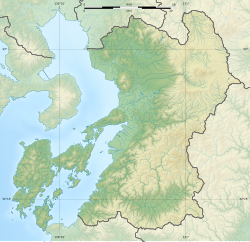Hitoyoshi Castle
| Hitoyoshi Castle | |
|---|---|
Người Cát Thành | |
| Hitoyoshi, KumamotoJapan | |
 Hitoyoshi Castle | |
| Coordinates | 32°12′39.9″N130°45′59.37″E/ 32.211083°N 130.7664917°E |
| Type | Japanese castle |
| Site information | |
| Controlled by | Sagara clan |
| Open to the public | yes |
| Condition | Archaeological and designated national historical site; castle ruins |
| Site history | |
| Built | Kamakura period, early Edo Period |
 | |

Hitoyoshi Castle(Người Cát Thành,Hitoyoshi-jō)was anEdo periodflatlands-styleJapanese castlelocated in the city ofHitoyoshi,Kumamoto Prefecture,Japan.Its ruins have been protected as aNational Historic Sitesince 1961.[1]It is No.93 on the list "100 Fine Castles of Japan".[2]Since theSagara clanwas appointedjitō(land steward) n theKamakura period,the clan inhabited this castle for 35 generations, for 670 years until theMeiji restorationof 1871.
Overview
[edit]Hitoyoshi Castle is located on the south side of theKuma Riverthat flows through the center of Hitoyoshi city, and is built on a mountain at the confluence of the Kuma River and its tributary, the Mune River. This is in the Hitoyoshi Basin, a 30 by 15 kilometer valley surrounded by tall mountains at the southern border of Higo Province. The Kuma River and Mune River serve as natural moats on the north and west sides, and the mountain slopes and cliffs serve as natural castle walls on the east and south sides. The San-no-maru (Third Enciente) is located along the Kuma River, the Ni-no-maru (Second Enciente) to the south, and the Hon-maru (Main Enciente ) on the hill, making it a flatland castle with a terraced structure. Main Enciente never had atenshucastle tower. In the [{Sengoku period]], there were also subsidiary castles called Uehara Castle, Nakahara Castle, and Shimohara Castle on the hills to the south, southeast, and east of the main castle, across the valley, but the ruins of these fortifications are not included in the current National Historic Site.[3][4]
Part of the stone wall of thedaimyōpalace built at the end of the Edo period is a unique stone wall called "Musha-gaeshi" that uses a European castle construction technique, in which the wall has a slight protruding from the top, which prevents enemies from climbing over the wall, and also allows defenders to attack enemies clinging to the wall. This type of wall is rare, and is only found in theGoryōkakuandTatsuoka CastleinHakodate,but neither of them are as large as the stone wall of Hitoyoshi Castle.
The castle ruins are now known as Hitoyoshi Castle Park, and someyaguraturrets and stonewalls have been restored. AShinto shrine,the Sagara Gokoku Jinja is now located on the west side of the castle ruins. The Hitoyoshi City Hall was formerly located within the castle, but was relocated after the damage caused by the2016 Kumamoto earthquakes.The Hitoyoshi Castle History Museum remains within the castle grounds.
History
[edit]Sagara Nagayori, a local lord of SagarashōeninTōtōmi Provincewho servedMinamoto no Yoritomo,was appointed as the land steward of HitoyoshishōeninHigo Provincein 1205. This area was ruled by Yase Sumasuke, a vassal ofTaira no Yorimori.Nagayori, he lured Sumasuke out under the pretense ofcormorant huntingand murdered him. Nagayori expanded Sumasuke's castle and built the foundations of Hitoyoshi Castle. During the construction of the castle, a stone with a crescent-shaped pattern was unearthed. For this reason, the castle is also known as "Sengetsu Castle" or "Mikazuki Castle." During the Sengoku Period, the Sagara clan unified the Kuma region. However, after an internal dispute over the succession issue, on July 14, 1526, Hitoyoshi Castle was surrounded by a large army led by the Kitahara clan (who were backed by theIkkō-ikkimovement). Sagara Yoshishige used a stratagem to drive the Kitahara clan back, but this was the only time that Hitoyoshi Castle was attacked by another clan after the Sagara clan entered the castle.[3]
After that, the 19th head of the family, Sagara Yoshiharu, began a major renovation of the castle during theTenshōera (1573-1593), which was only completed in 1639. During the Sengoku period, the Sagara clan endured constant threats from theShimazu clanin the south, and the Nawa clan andŌtomo clanin the north, and in 1581 they surrendered to the Shimazu clan and became their vassals. In 1587, Sagara Yorifusa fought bravely duringToyotomi Hideyoshi'sconquest of Kyushu,but surrendered, and was granted Hitoyoshi Castle and territory as an independent lord again through negotiations with his vassal, Fukamizu Nagatomo. In theBattle of Sekigaharain 1600, he initially sided withIshida Mitsunari's (Western Army) and attackedFushimi Castleand other castles, but after Ishida's defeat, he defected to theTokugawa(Eastern Army) and was granted confirmation in his own holdings with an assessedkokudakaof 22,000koku.[3]Under Sagara Yorifusa, Hitoyoshi Castle was modernized per contemporary castle technology, with stone walls andmasugata-style compound gates. The castle was also made more compact, with major part of old fortifications on the mountaintop abandoned. A long stone wall was also built along Kuma River, and river port was constructed.
Prior to theMeiji restoration,Hitoyoshi Castle was destroyed in a fire in 1862. Following the start of theMeiji period,the site of the castle became a park. The site is a 15 minutes walk fromJR KyushuHisatsu LineHitoyoshi Station..[3]
Gallery
[edit]-
Panorama from Kuma River
-
Hon-maru
-
Foundation stones in the Hon-maru
-
Ni-no-maru
-
San-no-maru
-
Stone walls of the Ni-no-maru and San-no-maru nhị の hoàn ・ tam の hoàn thạch viên
-
Musha-gaeshion stone walls
-
Otemon Tamon-yagura
-
Gate
See also
[edit]Literature
[edit]- Benesch, Oleg and Ran Zwigenberg (2019).Japan's Castles: Citadels of Modernity in War and Peace.Cambridge: Cambridge University Press. p. 374.ISBN9781108481946.
- De Lange, William (2021).An Encyclopedia of Japanese Castles.Groningen: Toyo Press. pp. 600 pages.ISBN978-9492722300.
External links
[edit]- Hitoyoshi Castle History Museum(in Japanese)
- Kumamoto official tourism site(in Japanese)
References
[edit]- ^"Người Cát Thành thành"(in Japanese). Agency for Cultural Affairs.Retrieved16 October2021.
- ^"続 Nhật Bản 100 danh thành"(in Japanese). Nhật Bản thành quách hiệp hội.Retrieved25 July2019.
- ^abcdIsomura, Yukio; Sakai, Hideya (2012).( quốc chỉ định sử tích sự điển ) National Historic Site Encyclopedia.Học sinh xã.ISBN4311750404.(in Japanese)
- ^"Hitoyoshi Castle Profile".Archived fromthe originalon 2016-12-28.Retrieved2016-05-20.












